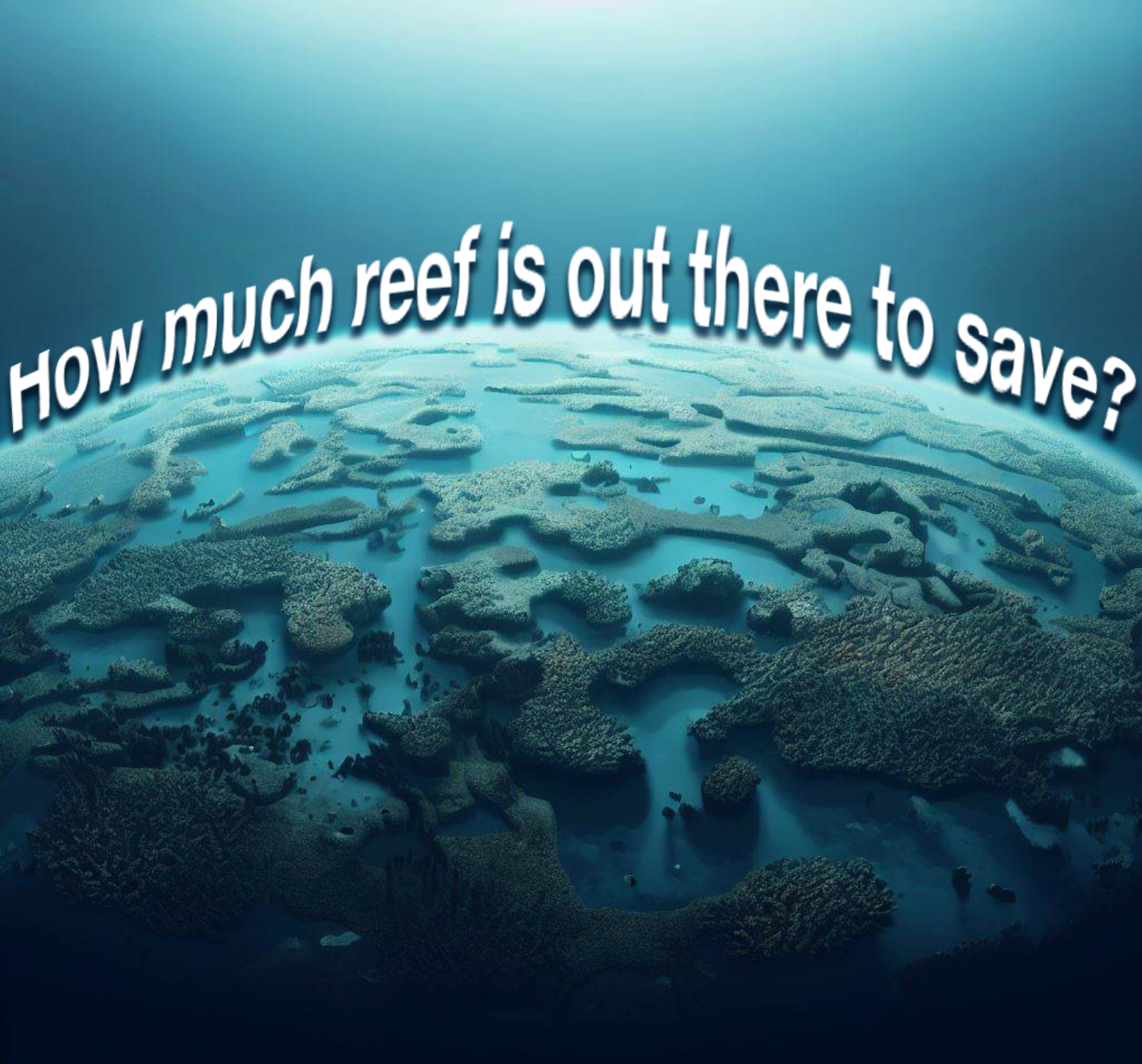How much coral reef is out there to save?
August 15, 2023
We did it! We completed our worldwide coral reef map and now monitor worldwide threats but everyone is still asking…
What is the global coverage of coral reefs?
423,589 km2 is the global reef cover determined by the Allen Coral Atlas ('Atlas'), similar in size to the land mass of Papua New Guinea!
Reef cover or reef extent refers to the total geographical area covered by a coral reef or a group of coral reefs. Our reef extent definition represents the total surface area of the reef ecosystem, including living and nonliving things that can exist on a shallow coral reef, such as seagrass, rocks, coral rubble (from storms, high waves action), sandy patches, algae beds and coral colonies (Kennedy et al. 2021). The new Atlas reef extent also includes deeper reef structures, reefs in turbid water and shallow intertidal areas. Our calculated global coral reef extent area may seem larger in comparison with past estimates due to the quality of satellite imagery and methods used - read more on our Reef Extent Science and Methods page.
So, what is the global coverage of coral habitat?
53,502 km2 is the worldwide coverage for Atlas coral/algae habitat, approximately the size of Costa Rica.
Coral habitat is the area where corals live, these marine invertebrates typically live in compact colonies of genetically identical individual polyps. Algae habitat includes freshwater and marine ecosystems, these simple, yet diverse organisms play a crucial role in the marine food web as primary producers, meaning they convert sunlight into energy through photosynthesis. Corals are dependent on some algae, the zooxanthellae, that live within coral tissues and provide essential nutrients to the coral through photosynthesis, contributing to the overall health and growth of coral reefs.
Credit: Allen Coral Atlas, coral/algae habitat class in coral pink
Coral/algae coverage is different from the above reef extent because coral coverage excludes sandy bottoms, rocky shores or rubble fields. The Atlas defines coral/algae coverage as a combined class of coral and algae habitat, shown in coral pink, above image.
Atlas mappers use a low tide Multispectral Planet Dove satellite seamless image mosaic, such as this one of the Maldives:

Credit: Allen Coral Atlas
Since coral and algae live a mutualistic relationship, unfortunately they look extremely similar from space, even to a trained eye.
As you see from the graph below, coral and algae are nearly the same reflectance values across all wavelengths. Since visible light is seen in ranges of wavelength in nanometers, this is a difficult task to pull these two habitats apart. So for now they are a combined class.

Credit: Torres-Madronero et al. 2009. Sand, coral and algae spectral signatures
Where are coral reefs located around the world?
Check out the Atlas global coral reef distribution, here.
Which country has the most coral?
1. Indonesia has the most coral reef habitat with 9,703 km2, nearly the size of Jamaica! The entire reef extent within Indonesia’s Exclusive Economic Zone (EEZ) covers 41,940 km2, approximately the size of The Netherlands! Check out reef locations here.
2. Philippines rings in at number two with 6,320 km2 covered by coral and algae habitat and 24,219 km2 coral reef ecosystem present within EEZ. Check out their coverage here.
3. Australia ranked third with 4,837 km2 coral and algae habitat and 37,181 km2 of coral cover within its EEZ. Look up more statistics here.
If you want to know about a country's coral reef abundance, use the Maritime Boundaries and Statistics features. See here:

Credit: Allen Coral Atlas
While limitations exist, including the exclusion of steep sloping deeper reefs and regions outside 30 degrees North and South, the Atlas remains a crucial resource for tracking marine protected areas distribution, statistics, and abundance globally.
How is reef extent used to solve big ocean issues?
Here are a few key areas:
- - Conservation and Management, i.e. identify areas that need protection, prioritization assessments, and guide plans for sustainable use
- - Biodiversity and Ecology, i.e. species composition, connectivity, and ecological interactions within and between different reef areas
- - Climate Change Impact, i.e. shrinking or expanding reef extent can indicate the health and resilience of coral ecosystems and help assess the vulnerability of reefs
- - Human Activities and Impact, i.e. guide sustainable development and reduce negative impacts, such as coastal development, pollution, overfishing, and tourism.
Why does global coral cover matter?
Overall, global coral reef extent serves as a critical metric for studying, monitoring, and managing coral reefs, allowing scientists, conservationists, and policymakers to make informed decisions, set targets and monitor progress to protect these valuable ecosystems.

Credit: Allen Coral Atlas
Wrap up
Identifying where coral reefs are located is the first step in preserving their existence. Allen Coral Atlas satellite imagery remote sensing techniques are advanced technologies used to estimate and monitor coral reefs around the world accurately. From the Allen Coral Atlas survey, over 2,800 practitioners worldwide are using the Atlas to study, manage and conserve coral reef ecosystems. Global threats to coral reefs are profound, monitoring the reef over time can provide valuable insights into the impact of environmental factors, such as climate change, pollution, coastal development, and other human activities on these delicate ecosystems. See more on reef threats coming soon.
How to participate
If you are monitoring coral reef bleaching, please reach out to our team member, Dr. Andrea Rivera- Sosa, arivera-sosa@coral.org, or sign up here with Adventure Scientists to help ground truth the Atlas and be a guardian of our vibrant coral ecosystems.
References
Maria C. Torres-Madronero, Miguel Velez-Reyes, James A. Goodman (2009). Proceedings Volume 7473, Remote Sensing of the Ocean, Sea Ice, and Large Water Regions; https://doi.org/10.1117/12.835896
Kennedy, E., C. M. Roelfsema, M. B. Lyons, E. Kovacs, R. Borrego-Acevedo, M. Roe, S. R. Phinn, K. Larsen, N. Murray, D. Yuwono, J. Wolff and P. Tudman (2021). "Reef Cover, a coral reef classification for global habitat mapping from remote sensing." Scientific Data.
